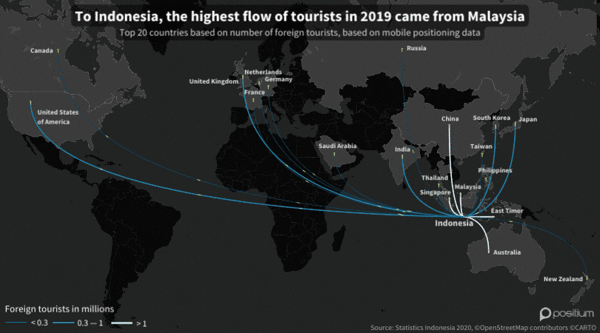The country received in 2019 a revenue from foreign tourism that corresponds to the 1.6% of its Gross National Product (GNP). Currently, the country is recovering as a touristic destination after the effects of the COVID-19 pandemic.
Since 2016, Indonesia’s Ministry of Tourism together with the statistical agency Badan Pusat Statistik (BPS) has been using mobile positioning data to release monthly cross-border tourism statistics as part of the official statistics.
In 2019, the flows of foreign tourism to Indonesia had a significant difference in 5 countries (white lines on the map). The highest flow of tourism came from Malaysia with 2.9 million visitors (18.5%), followed by China with 2 million (12.9%), then Singapore with 1.9 million (12%), Australia with 1.3 million (8.6%), and East Timor with 1.1 million (7.3%). Generally, these 5 countries represent 59% of the total foreign visitors from all around the world.
As the map shows, Indonesia mostly attracts visitors from countries located in Asia and Oceania. However, some European countries are part of the Top 20 as well, such as France (1.8% of the total), Germany (1.7% of the total), and the Netherlands (1.3% of the total). The highest flow came from the United Kingdom with 2.5% of the total. Countries from America have some representation as well, such as the United States of America (2.8% of the total) and Canada (0.6% of the total). Saudi Arabia is the only country from the middle east in the Top 20 representing 1% of the total.
Mobile positioning data is an efficient data source to generate tourism statistics as has been seen in the Indonesian example. The pseudonymised data source is accurate and reveals insights that are not possible to measure with traditional sources.
To learn more, read the article: ‘The Science Behind Generating Tourism Statistics from Mobile Positioning Data’
.png)
